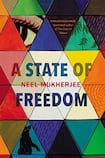
Four primary stories make up Neel Mukherjee's A State of Freedom. Death reaches into the shimmering precincts of the great Mogul monuments of the Taj Mahal and Fatehpur Sikri. A cosmopolitan food writer visits his middle-class parents in Kolkata. A poor villager acquires a bear cub and brutalises it into a carnival attraction. A child witnesses her brother's arm being hacked off by Maoist guerillas and then is sent to the city as a servant. Each story is intimate and universal, concrete and elusive. The reader is not dispatched to encounter India but invited to watch as the central characters draw it about themselves. The defeating multiplicity of the place is resolved with skill and subtlety.
Faces emerge from India’s 1.3 billion people and are then submerged. The connections between each section of the book are as much intuitive as explicit. You have to be alert. Slight incidents become vital components of the narrative. The indigent worker falling to his death from scaffolding in the first chapter – no more than an inconvenience to tourists – haunts the final pages. The mangy bear and his handler begging in traffic become the central section of the novel. You never meet the protagonist of the first section again, but the fox-faced village twins whose mother was cursed by the forest, briefly encountered and forgotten, become the heart of the book.
Power structures
Authority has failed in Mukherjee’s India. Asymmetric power structures distort relationships between employer and employee, peasant and businessman, in marriage and in family. Corruption and exploitation are everywhere. The vile strata of caste repel. The village girl Milly’s world is dictated by such false authority. There’s her brother’s severed arm. Her friend Sona’s sister is raped by a militia tasked with exploiting the forest and expelling the poor.
Neel Mukherjee isn't a polemicist, although there is plenty to be polemical about. His world is textured and complex
Mukherjee isn’t a polemicist, although there is plenty to be polemical about. His world is textured and complex. The mutilation of a bear cub to make it compliant is excruciating, but so is the despair of its trainer, Lakshman, as he struggles to escape the confines of the village. For the poor their world is jerrybuilt, slums are flooded, possessions are makeshift and sparse. Compassion for the natural world is an indulgence. Everything corrodes and rots. Everywhere the stink of excrement. A young mother takes her own life when she cannot find medical care for a facial tumour.
Milly is sent away at eight to become a servant girl in the city, her rudimentary schooling over. She sleeps on the kitchen floor, is caught eating the pages of a jotter in the hope that the words will somehow transmit themselves from her belly to the brain. She has found herself employed by the parents of the unnamed food writer home from London. His is the least sympathetic point of view in the book, but he casts a necessary eye on social hierarchies. He is a cool, cosmopolitan presence, a shrewd commentator on what is in front of him, but ultimately is as constrained as his parents. Self-awareness runs up against the iron rule of convention.
The role of food
Where authority fails, food plays its part. Elemental need raised to esoteric undercurrent, something imperative about its place in Indian culture, binding the lowly to the exalted. The named dishes and ingredients are glorious. Sai bhaji, toori chana dhal, tamarind and fresh mustard paste, panch phoron, fennel seeds and julienned ginger. Jewel spices sputtering in hot mustard oil. Cuisines that infiltrate the imagination as the unseen infiltrates the soul. When the orphan fox twins are given tangerines their friends believe that little cloves – chora – for motherless boys have been placed in the fruit by their dead mother's soul. A lyric outcome, but when Lakshman finds that his wife has been feeding their children eggs gifted by an employer, his authority is wounded and he beats her.
For all that the book teems with the agonies of the poor, the unrelieved fractals of suffering, there is light. Sona attempts to find a way out with the Maoist rebels in the threatened wilderness, but the forest shadows prove too much for their slender doctrine. Milly has nailed the way out from the start. It’s too late for her but not for her children. Education is the key, and she’ll give as much of herself as she has to so that they may prosper.
On the periphery
A State of Freedom is ambitious, and it succeeds on all levels. Mukerherjee picks out the individual and allows them to stand for the whole. Themes and issues give coherence to distinct stories. From afar it's easy to share the determinist underpinnings of the subcontinent. Things are the way they always have been. What is one life among so many? When the food writer remonstrates with his father over his harsh treatment of a child servant, the father's reaction is puzzlement rather than anger. What has possessed his son to behave in this way?
Mukherjee strikes at the centre of things by engaging with the periphery
Mukherjee strikes at the centre of things by engaging with the periphery. He is consistently alert to esoteric connections, to the “notion of an order of things created by the imagination residing under the visible world and as visible as the the real one”.
The final sequence elevates the entire work into that very order of things. The voice of the fox boy is raised above the voiceless, syntax falls away, tongue is given to the ruin and the glory, the unknown labourer is set among the transcendent, the one as vital as the many.
Eoin McNamee is the author of the Blue Trilogy









